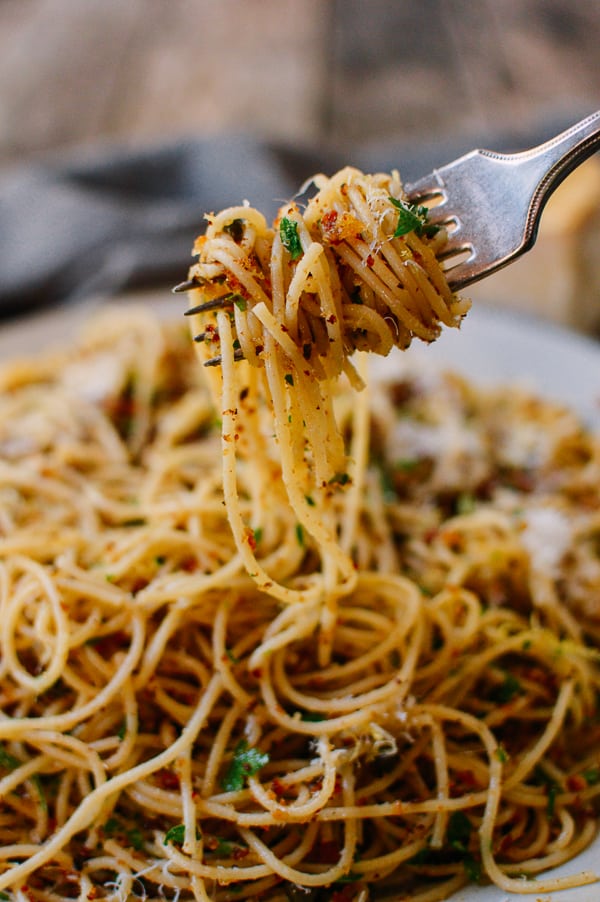Pasta with anchovies and breadcrumbs (Pasta con acciughe e mollica)

Portions: Serves 6
Ingredients:
Preparation:
Coat the bottom of a heavy frying pan with 1 tablespoon of olive oil. Add the breadcrumbs and toast them over a low heat, stirring constantly, until they are a rich golden brown. Put them in a small serving bowl and set aside. Put 5 tablespoons olive oil in a frying pan, add the garlic cloves, slightly crushed but still of a piece. Sauté the garlic until it begins to colour, then discard. Add the tomato extract and the water to the hot oil, stirring until the extract is completely dissolved. Simmer over very low heat for about 10 minutes. Meanwhile, cook the spaghetti in a large pot of boiling water, only lightly salted since both the tomato extract and the anchovies are very salty. In a separate pan or a double boiler (I always use a small double handled frying pan that will sit on top of my spaghetti pot), cook the anchovies together with 1 teaspoon of olive oil, stirring them until they dissolve into a cream. This must be done over steam and not over the direct heat, lest the anchovies turn bitter. Add the anchovies to the tomato sauce and simmer 2 to 3 minutes longer. Drain the spaghetti when cooked al dente, reserving 225 ml/8 fl oz of the cooking water. (This is always a wise precaution when preparing pasta with a very concentrated sauce or with breadcrumbs a few tablespoons of the reserved liquid will correct any eventual dryness). Place the spaghetti in a large bowl, add the sauce, and mix thoroughly, pouring in a little of the reserved liquid if necessary. Sprinkle with some of the breadcrumbs and with the parsley. Pass the remaining breadcrumbs on the side. Sicilians use different kinds of breadcrumbs for different purposes. What I call dried breadcrumbs are the ordinary crumbs grated from stale bread, crust and all, which can be either purchased or prepared at home. When browned in oil as in this recipe, these become toasted breadcrumbs. A third variety are what I shall call stale white breadcrumbs, meaning more specifically the white part of 2 to 3 day old semolina flour bread that has been grated, sieved to remove any big pieces, and allowed to dry for a day or two (a barely warm oven can speed this process). If these breadcrumbs are not thoroughly dry, they will become gluey. Purists require that this recipe be prepared using ’u ’strattu, tomato extract that is obtained from enormous expanses of bright red tomato purée salted and spread out on boards to dry in the sun until it hardens into a very dark red paste with the consistency of clay. The ’strattu gleaming in the bright summer sunlight, together with the pennuli, a sort of thick skinned cherry tomato hung up in bunches on the wall to keep until December, make bright splotches of red pigment along the whitewashed streets of Sicilian villages, but it is rarer and rarer that you see it nowadays. As far as I know the ’strattu produced today is marketed only on a very small and very local scale: most Palermo groceries have bowls of it on their counters and weigh it out by the spoonful. Given the success that sun dried tomatoes are currently enjoying, I cannot believe that it will be long before ’strattu appears here. Until its moment comes, however, those who are curious, and can count on two days of very hot sun, can try making their own.

